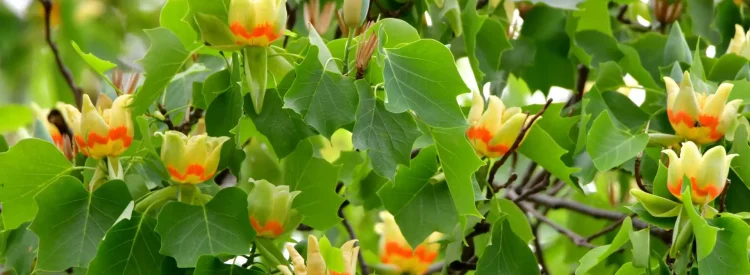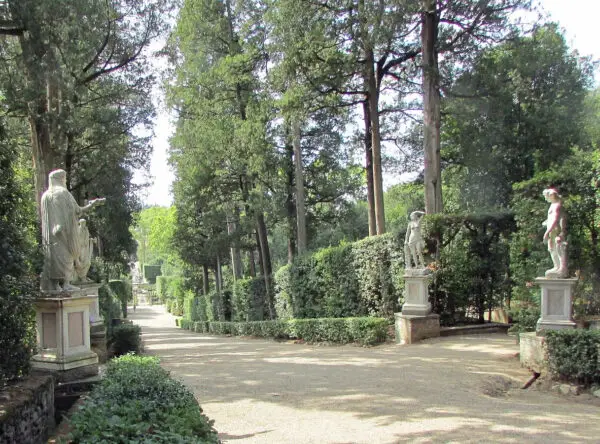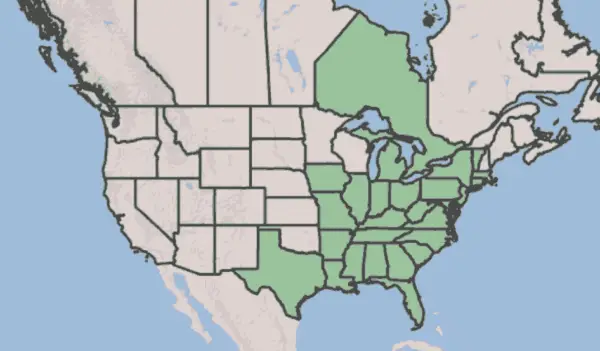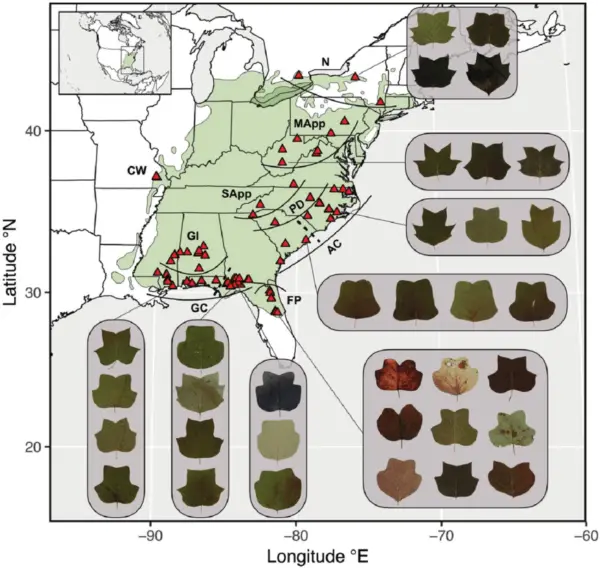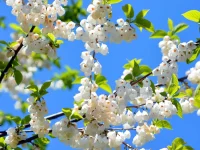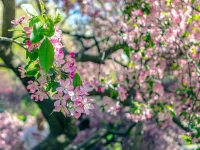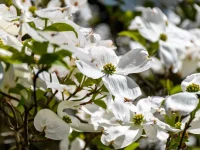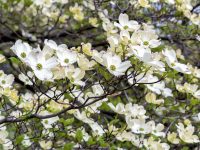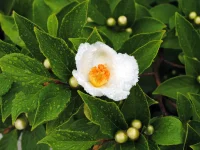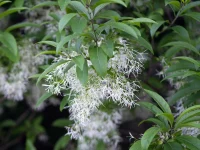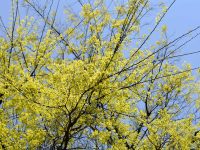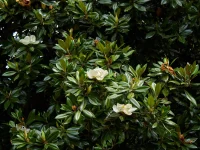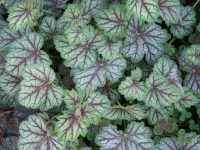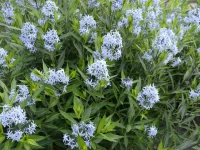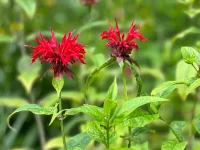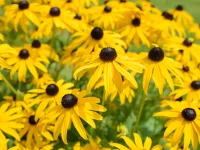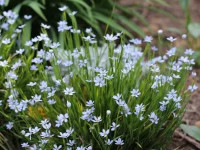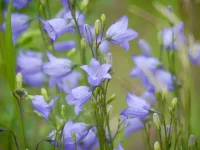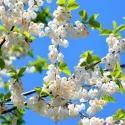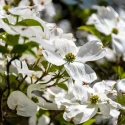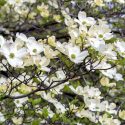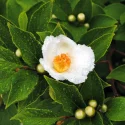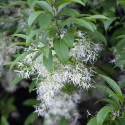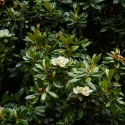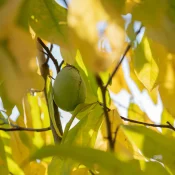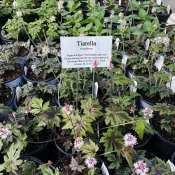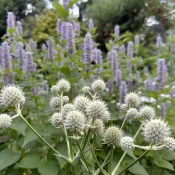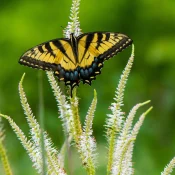Tulip Poplars are magnificent native trees known for their striped, vibrant spring flowers and flower-shaped leaves. In the fall, their leaves transform into a rich buttery yellow. These fast-growing colossal giants can reach over 100 feet and have a lifespan of 200+ years. They are also ancient trees, dating back to the time of dinosaurs. Plant a Tulip Poplar and it will return generations of beauty and food for pollinators. Scroll on for planting tips.
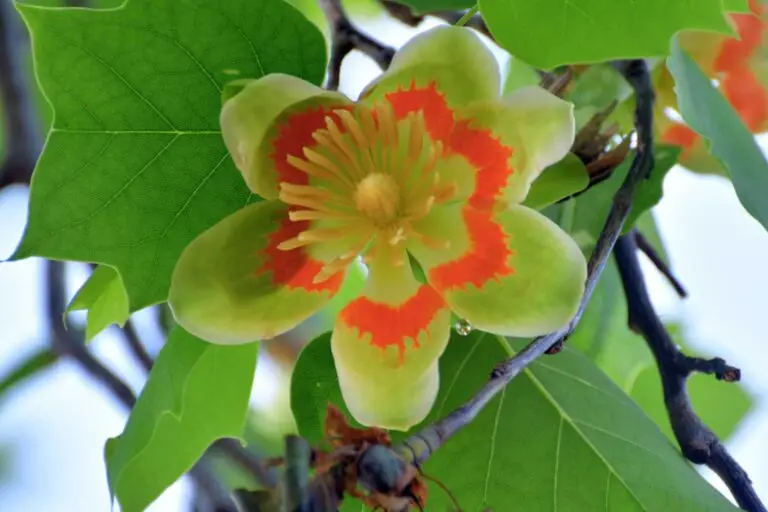
The Tulip Poplar (Liriodendron tulipifera) is an incredible native tree that really needs to have its own festival season. (As mentioned elsewhere on The Plant Native…why do we have cherry blossom festivals but not Redbud or Tulip Poplar festivals?!) This tree is a gem worth considering when looking for a beautiful and fast-growing addition to your yard. In this article, we’ll briefly introduce the Tulip Poplar’s incredible history, share planting tips, and end with some sourcing ideas.
Let’s dig in with a basic question…
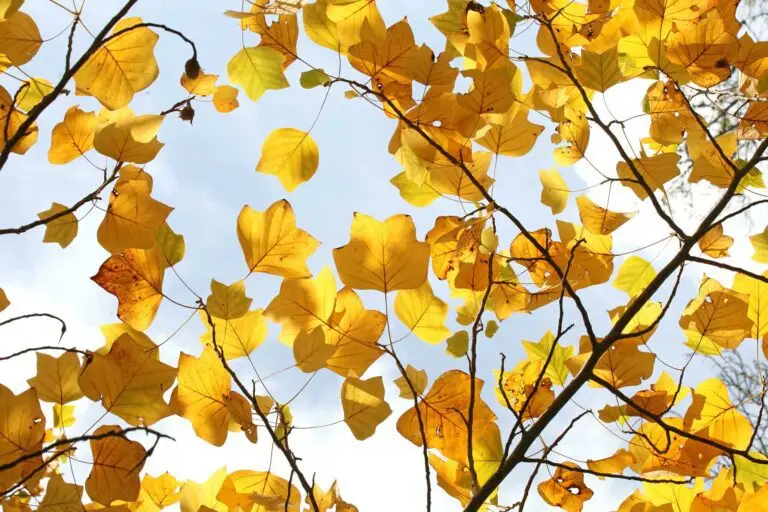
Why is it called Tulip Poplar?
Its common name is Tulip Poplar, given to it not because of its striking flowers but because of its leaves. Tulip Poplar’s unique leaves look like tulip flowers, hence the name. These leaves turn a beautiful golden yellow in the fall, making them a favorite among many homeowners and landscapers. In the spring, the tree blooms with yellow and green tulip-shaped flowers, which makes it a great source of nectar for bees and other pollinators.
These majestic trees provide a living link to Earth’s distant past. Tulip Poplars have roots that stretch back to the time of the dinosaurs, making them more than just beautiful—they’re a reminder of the ancient world right in our backyards.
Here’s how:
The incredible history of Tulip Poplars
Tulip Poplars have been found in fossils. It’s fascinating to think that some plants have been around for millions of years. Tulip Poplars are one of these ancient plants. Scientists have found Tulip Poplar species as far back as the Cretaceous period. Only two Tulip Tree species have survived today: one is our beloved North American native and…
There is only one other tulip tree around, and it’s in Asia
The Tulip Poplar is unique among trees. The next closest tulip-y tree that exists in the world is the Chinese Tulip Tree (Liriodendron Chinense), which shares quite a few similarities but is native to the other side of the globe.
Tulip Poplars are related to magnolias, another gorgeous flowering tree with nine native species.
You might spot a Tulip Poplar in Florence, Italy
European botanists discovered Tulip Poplars in North America in the 1600s and shipped them back to Europe to be planted in parks and gardens.
In her excellent book Botanica North America, Marjorie Harris writes, “It’s an astonishing sight to visit one of the major Italian gardens, the Boboli in Florence, and see a massive tulip tree in full May bloom.”
And finally, Tulip Poplars are the state tree of three states
Tulip Poplars are beloved, even at the government level. Tulip Poplars are the state tree of Indiana, Kentucky, and Tennessee.
That’s a quick overview of this plant’s incredible history. Now, let’s dig into the plant’s four-season beauty and planting tips.
Four seasons of Tulip Poplars
Let’s talk about the four seasons and how the Tulip Poplar changes throughout.
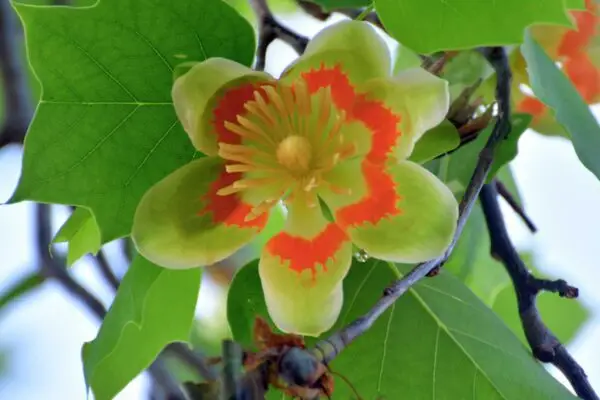
Spring
Mature Tulip Poplars bloom with yellow and green tulip-shaped flowers. In the largest of trees, these flowers put gardens high up in the tree canopy.
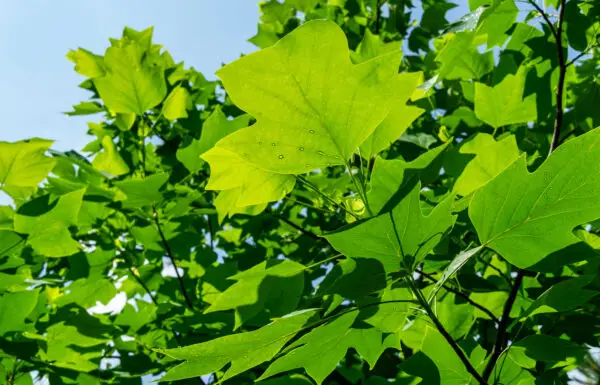
Summer
The flowers drop but the leaves stay, providing ample shade, keeping yards cool on hot summer days.
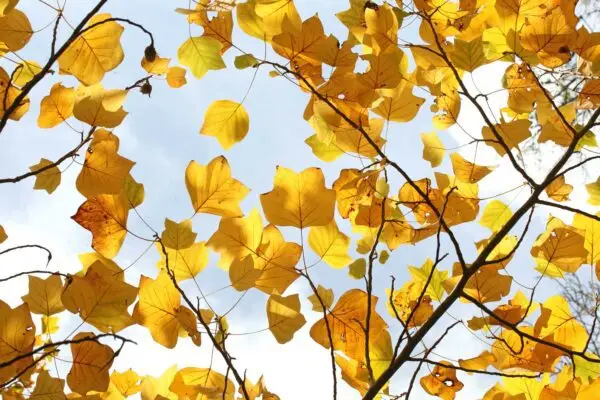
Fall
The leaves turn a beautiful golden yellow, adding to the fall foliage show.
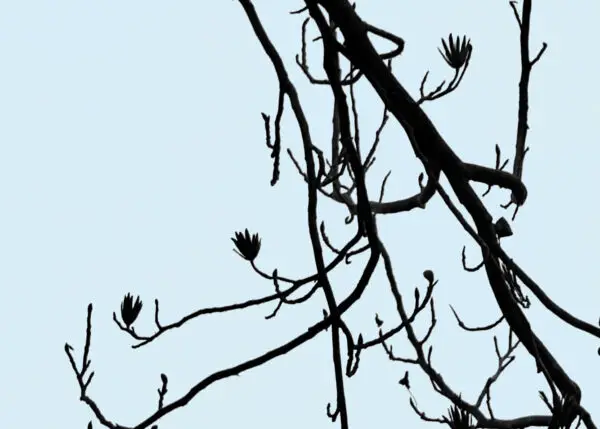
Winter
You would think this tree's beauty would go dominant in the winter, but it still offers something to admire. After the leaves drop, the flower remnants remain. Set against an overcast winter sky, it becomes a sculpture garden filled with birds.
Some tips for planting Tulip Poplars
When planting Tulip Poplars, there are a few things to remember.
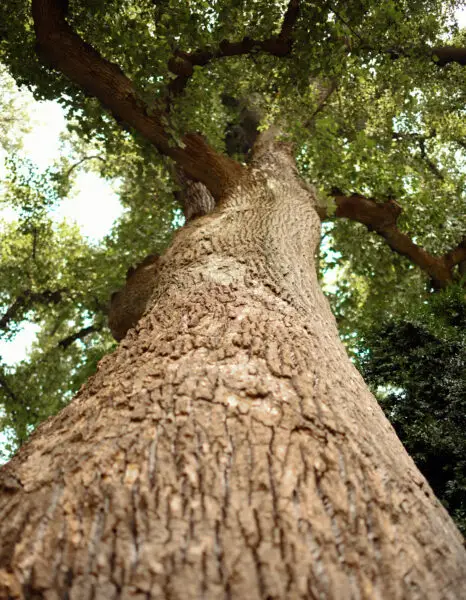
These are BIG trees
The US Department of Agriculture describes them as “among the tallest broadleaf trees in eastern US forests.”
Tulip Poplars can grow up to 150 feet tall, so make sure you have enough space to plant them. They also require well-draining soil and full or part sun to thrive, so be sure to plant them in a spot that receives plenty of sunlight.
Finally, they don’t tolerate compacted soil or salt spray, so be cautious if you’re planting one near a road.
Where is Tulip Poplar native?
Tulip Poplars are native to almost half of the United States and a portion of Canada. Gardeners from Vermont to Florida, and west to Texas can plant a Tulip Poplar.
This is a HUGE native range
From Ontario to Texas is quite the range! You can imagine that the DNA of a Tulip Poplar from Texas will differ from that of a Tulip Tree from Vermont.
The picture here comes from botanists in the Journal of Plant Sciences who surveyed 144 Tulip Poplars across the eastern United States. Even a glance shows how the DNA can shift across regions. And this is the DNA we can see!
Provenance is a secret gardening tip
Planting a tree from one region in a completely different region is why some garden plants fail. For example, ordering a Tulip Poplar online from a Texas-based company and planting it in Vermont might seem convenient, but the cold Vermont winters could doom the tree to failure.
This happens because plants have micro-level differences in their DNA adapted to specific regions. In the case of the Tulip Poplar, these adaptations result from thousands of years—even millions of years—of evolutionary fine-tuning. A plant’s location-specific preferences are often referred to as its provenance.
Perhaps you don’t have time to remember botanist vocab. We get it. Here’s a silly rhyme to help remember plant provenance:
Plants and seeds grown close to home are tuned to your soil, weather, and pollinators. Stay within 500 miles—or about a day’s drive—to help your garden thrive naturally.
We’ve covered the history, seasonality, and growing tips. Now let’s begin to close out our love letter to Tulip Poplars with some FAQs and sourcing ideas.
FAQs
How long does it take for a Tulip Poplar to flower?
On average, a Tulip Poplar needs to be 20 years old before it flowers. But all that patience pays off for generations: it will continue to flower for the next two centuries. (There are some native Tulip Poplars believed to be almost 500 years old.)
How fast do Tulip Poplars grow?
The Tulip Poplar is a fast-growing tree. In the right conditions, it can grow up to 2-3 feet per year. Planting trees can oftentimes feel like such a slower process (but it’s always worth it.) With Tulip Poplars, you can enjoy its beautiful appearance and benefits in a relatively short amount of time.
Where can I find a Tulip Poplar for my yard?
You would think that a tree that has been around for millions of years would be easy to find. Sadly, like most native plants, finding a Tulip Poplar can take some extra work.
To make things easier, we’ve compiled four trusted sources where you can reliably find a Tulip Poplar:
Where can I find seeds and plants?
Finding native plants can be challenging (we partly blame Marie Antoinette.) To make it easier, we’ve assembled four sourcing ideas.
300+ native nurseries make finding one a breeze
Explore 100+ native-friendly eCommerce sites
Every state and province has a native plant society; find yours
Online Communities
Local Facebook groups are a great plant source
What are good Tulip Poplar pairings?
Pair Tulip Poplars with shrubs, smaller trees, and flowers that thrive in same light. Some examples include:
Native Shrub + tree pairings
Native flower pairings
In conclusion, the Tulip Poplar is a stunning tree that is perfect when you have lots of space for a statement tree. Its unique appearance, fast growth, and ability to thrive in the right conditions make it a great choice for any yard or park. Consider the Tulip Poplar if you’re looking for a shade tree or want to add some visual interest to your yard. If you’re interested in other flowering native trees, visit our Beginner’s Guide to Native Magnolias, Beginner’s Guide to Native Dogwoods, or our profile of the undersung bird-favorite Hackberry tree. Happy planting!
Sources
- Fetter, Karl C., and Alan Weakley. “Reduced Gene Flow From Mainland Populations of Liriodendron Tulipiferainto the Florida Peninsula Promotes Diversification.” International Journal of Plant Sciences 180, no. 3 (February 12, 2019): 253–69. https://doi.org/10.1086/702267.
- Harris, Marjorie. Botanica North America: The Illustrated Guide to Our Native Plants, Their Botany, History, and the Way They Have Shaped Our World. (2003), 43-44.
- Nelson, Gil. Best Native Plants for Southern Gardens: A Handbook for Gardeners, Homeowners, and Professionals. (2010), 213-214.
- Nie, Ze-Long, Jun Wen, Hiroshi Azuma, Yin-Long Qiu, Hang Sun, Ying Meng, Wei-Bang Sun, and Elizabeth A. Zimmer. “Phylogenetic and Biogeographic Complexity of Magnoliaceae in the Northern Hemisphere Inferred From Three Nuclear Data Sets.” Molecular Phylogenetics and Evolution 48, no. 3 (June 23, 2008): 1027–40. https://doi.org/10.1016/j.ympev.2008.06.004.
- Romanov, Mikhail S., and David L. Dilcher. “Fruit Structure in Magnoliaceae s.l. And Archaeanthus and Their Relationships.” American Journal of Botany 100, no. 8 (August 1, 2013): 1494–1508. https://doi.org/10.3732/ajb.1300035.
- United States Department of Agriculture, Tulip Poplar Plant Guide. (PDF).
- United States Department of Agriculture, Tulip Poplar Plant Fact Sheet. (PDF).
- USDA Plants Database, Liriodendron tulipifera.
- The BRAHMS Project, University of Oxford, Department of Plant Sciences. “Oxford University Plants: Liriodendron Tulipifera.”
What if your feed was actually good for your mental health?
Give your algorithm a breath of fresh air and follow us.
